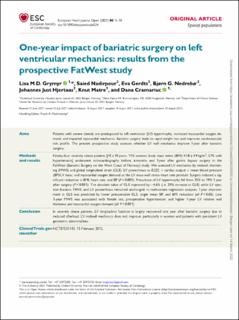| dc.description.abstract | Aims
Patients with severe obesity are predisposed to left ventricular (LV) hypertrophy, increased myocardial oxygen demand, and impaired myocardial mechanics. Bariatric surgery leads to rapid weight loss and improves cardiovascular risk profile. The present prospective study assesses whether LV wall mechanics improve 1 year after bariatric surgery.
Methods and results
Ninety-four severely obese patients [43 ± 10 years, 71% women, body mass index (BMI) 41.8 ± 4.9 kg/m2, 57% with hypertension] underwent echocardiography before, 6 months and 1 year after gastric bypass surgery in the FatWest (Bariatric Surgery on the West Coast of Norway) study. We assessed LV mechanics by midwall shortening (MWS) and global longitudinal strain (GLS), LV power/mass as 0.222 × cardiac output × mean blood pressure (BP)/LV mass, and myocardial oxygen demand as the LV mass-wall stress-heart rate product. Surgery induced a significant reduction in BMI, heart rate, and BP (P < 0.001). Prevalence of LV hypertrophy fell from 35% to 19% 1 year after surgery (P < 0.001). The absolute value of GLS improved by—4.6% (i.e. 29% increase in GLS) while LV ejection fraction, MWS, and LV power/mass remained unchanged. In multivariate regression analyses, 1 year improvement in GLS was predicted by lower preoperative GLS, larger mean BP, and BMI reduction (all P < 0.05). Low 1-year MWS was associated with female sex, preoperative hypertension, and higher 1-year LV relative wall thickness and myocardial oxygen demand (all P < 0.001).
Conclusion
In severely obese patients, LV longitudinal function is largely recovered one year after bariatric surgery due to reduced afterload. LV midwall mechanics does not improve, particularly in women and patients with persistent LV geometric abnormalities. | en_US |

